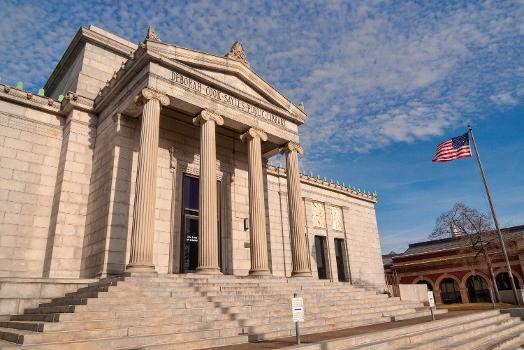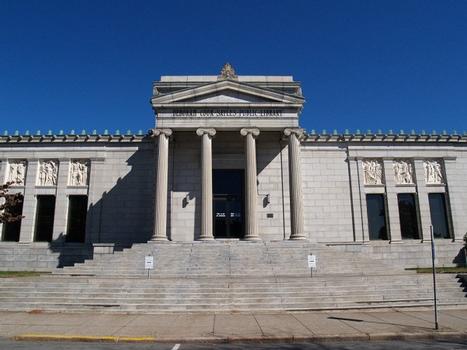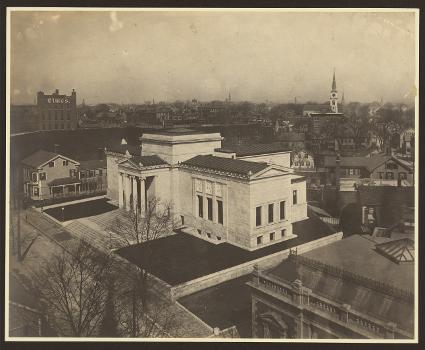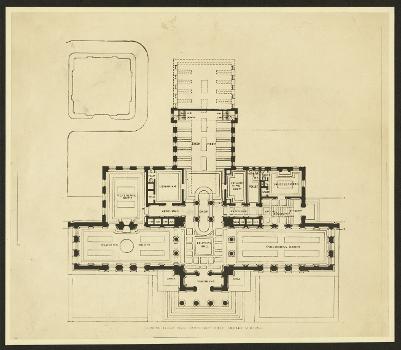General Information
| Other name(s): | Deborah Cook Sayles Public Library |
|---|---|
| Beginning of works: | 1899 |
| Completion: | 1902 |
| Status: | in use |
Project Type
| Function / usage: |
Library |
|---|---|
| Architectural style: |
Neoclassical |
Awards and Distinctions
| 1975 |
for registered users |
|---|
Location
| Location: |
Pawtucket, Providence County, Rhode Island, USA |
|---|---|
| Address: | 13 Summer Street |
| Connects to: |
Gerald S. Burns Building (1897)
|
| Coordinates: | 41° 52' 43.71" N 71° 23' 4.25" W |
Technical Information
There currently is no technical data available.
Excerpt from Wikipedia
The Pawtucket Public Library, formerly known as the Deborah Cook Sayles Public Library, is located at 13 Summer Street in Pawtucket, Rhode Island. Its main building, designed by Ralph Adams Cram and built in 1899-1902, and was a gift to the city from Pawtucket's first mayor, Frederic Clark Sayles, in memory of his recently deceased wife. In the late 1970s, an addition was built to connect the library to the neighboring Pawtucket Post Office, which had been built in 1896, had served as the post office until 1941, and which now forms part of the library's infrastructure as the renamed Gerald S. Burns Building.
History
The library was founded as the Pawtucket Library Association in 1852. This group purchased private libraries around the city, and in 1876 gifted its 4,700 volumes to the town for public use. The library's first librarian was Minerva Sanders, who worked there until her retirement in 1910. Sanders was nationally recognized for her innovative services such as allowing open access to book stacks and permitting children to use the library.
By 1898, it became clear that the library needed a permanent home. A competition, held to select a design for a new library building, attracted entries from twenty-four architects. The winner was submitted by the Boston firm of Cram, Goodhue & Ferguson. The building's cornerstone was laid on Nov. 18, 1899, and the building opened on Oct. 15, 1902. The library was the first in the nation to allow patrons to browse the shelves directly, instead of requiring a librarian to retrieve books for them.
Architect Raymond Hood, a Pawtucket native, and sculptor Lee Lawrie, a team who much later became known for their work on Rockefeller Center, worked on the library building while in the employ of Boston architectural firm Cram, Goodhue & Ferguson.
An expansion to the library in the 1960s has been called "awkward and insensitive."
The library's main building was listed on the National Register of Historic Places in 1975; the connected former Pawtucket Post Office building was listed in 1976. Efforts began in 1979 to renovate and join the two buildings, with work completing in 1982. The post office building was dedicated as the Gerald S. Burns building, and together with the Deborah Cook Sayles Public Library building, became what is known today as the Pawtucket Public Library.
Deborah Cook Sayles Public Library building
The Classical Revival building features ionic columns, a pediment, egg-and-dart moldings, with high relief panels on its wings. The main façade is closely styled after the north porch of the Erectheion on the Acropolis in Athens, Greece.
Reliefs
The six bas-reliefs above the library windows depict scenes from literature and mythology. Depicted are scenes from the German epic poem Nibelungenlied, Dante's Inferno, and scenes from Shakespeare and King Arthur. Across the library's front doors are depictions of Moses, as well as Egyptian, Greek, and Roman figures of law and wisdom.
The sculptures were designed by Lee Lawrie and carved by Hugh Cairns. These reliefs were Lawrie's first ever commission. Lawrie would go on to become "one of the country’s foremost architectural sculptors."
Text imported from Wikipedia article "Pawtucket Public Library"
and modified on 23 February 2022 according to the CC-BY-SA 3.0 license.
Participants
-
Cram, Goodhue and Ferguson
- Ralph Adam Cram (architect)
Relevant Web Sites
- About this
data sheet - Structure-ID
20047973 - Published on:
25/08/2009 - Last updated on:
24/02/2022









